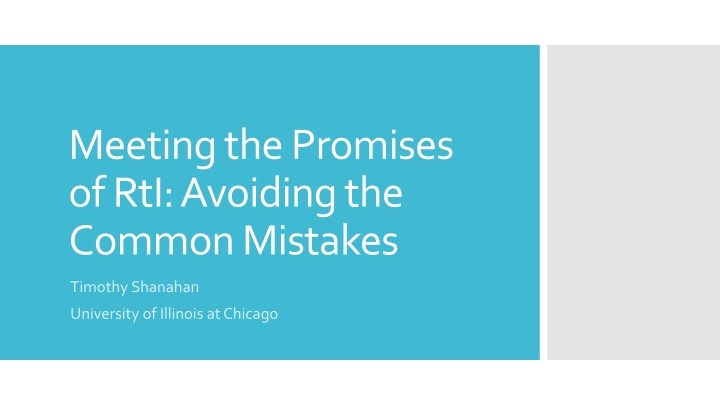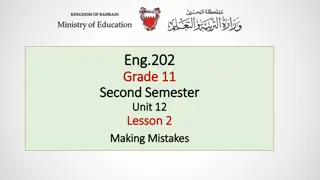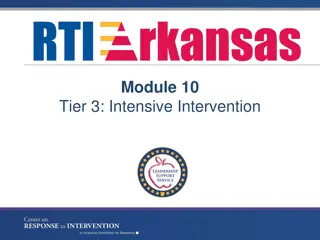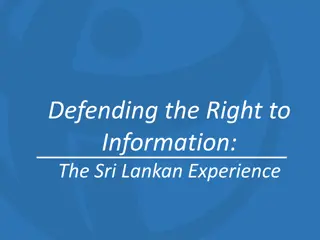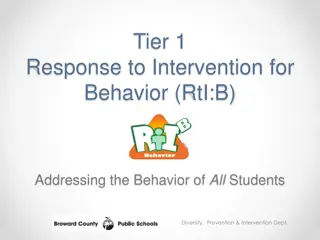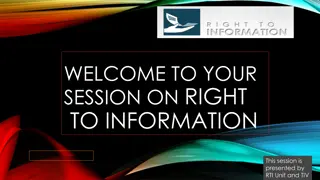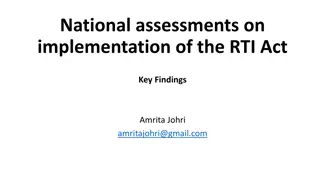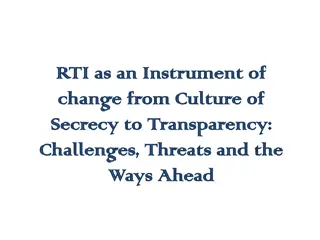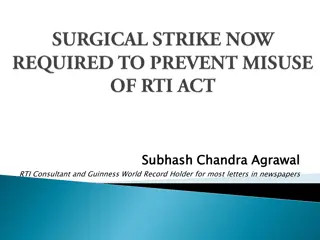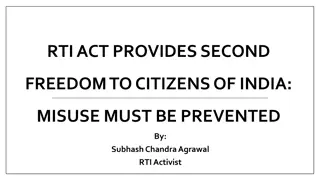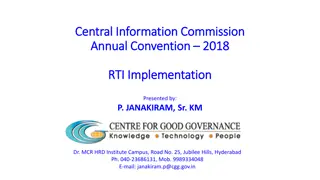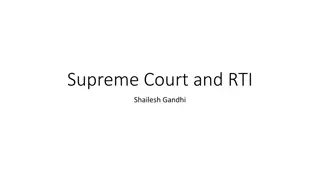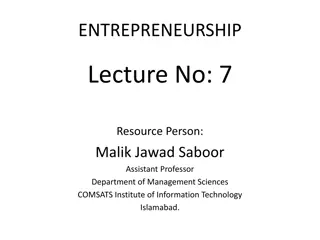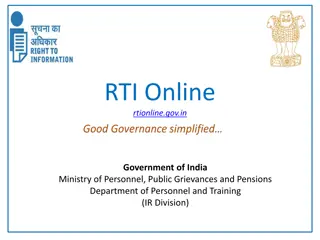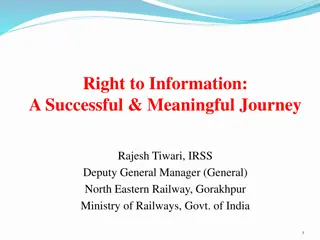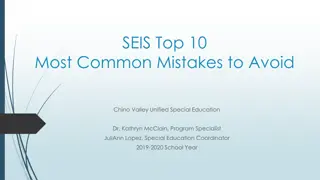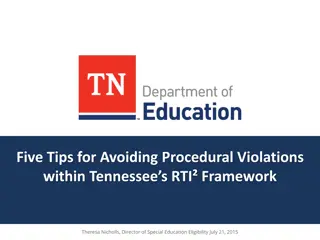Meeting the Promises of RtI: Avoiding Common Mistakes
Special education has faced challenges in identifying learning problems, leading to ineffective interventions. Understanding the keys to successful Response to Intervention (RtI) implementation is crucial, emphasizing strong Tier 1 instruction and avoiding common pitfalls for improved student outcomes.
Download Presentation

Please find below an Image/Link to download the presentation.
The content on the website is provided AS IS for your information and personal use only. It may not be sold, licensed, or shared on other websites without obtaining consent from the author.If you encounter any issues during the download, it is possible that the publisher has removed the file from their server.
You are allowed to download the files provided on this website for personal or commercial use, subject to the condition that they are used lawfully. All files are the property of their respective owners.
The content on the website is provided AS IS for your information and personal use only. It may not be sold, licensed, or shared on other websites without obtaining consent from the author.
E N D
Presentation Transcript
Meeting the Promises of RtI: Avoiding the Common Mistakes Timothy Shanahan University of Illinois at Chicago
How to Make Response to Intervention Effective A multi-tier approach to the identification and instructional support of students with special learning and behavioral needs Begins with high quality instruction and universal screening of children Provides additional instructional support (interventions) of varied levels of intensity Timothy Shanahan University of Illinois at Chicago www.shanahanonliteracy.com
Historically, special education had serious problems in identifying learning problems including having to wait until students were suffering from serious academic failure before help could be provided, identifying students in ways that offered no direction for remediation, and lack of validity (e.g., LD students were not different from others in their response to instruction) What does it mean to work ? Success can be measured in many ways including reductions in special education case loads, and improvement in achievement levels of those students (as well as the students in the general education population)
RtIhas become a widely used approach through U.S. schools over the past 15 years What have we learned about making RtI successful? Research has revealed that many of those efforts have not been successful (e.g., overall achievement levels have not changed, students receiving interventions have not made gains, special education case loads have not been reduced) This presentation will explore some of the mistakes that should be avoided in future RtIimplementation
The most ignored feature in RtIis strong Tier 1 instruction There are various reasons for learning problems (e.g., disabilities, lack of learning opportunity, poor instruction) No matter what the problem students will receive most of their instruction in the regular classroom so it is critical that this be made profitable Make sure Tier 1 teaching is strong Don t just look at program, but at implementation (how much teaching are students receiving in key skill areas, how good is this instruction) What in-class supports are provided (to enhance attention, to increase responsiveness, etc.)?
Of course, it is important to select screening and monitoring tests that have good reliability and validity statistics Use only reliable and valid testing procedures However, reliability and validity are not properties of tests, but of testing It is crucial that test administrators are well-trained (and frequently recalibrated) and that the testing procedures match those in the reliability and validity studies
It is important to monitor students learning progress to ensure that they are receiving sufficiently intense learning experiences However, frequent testing does not make RtI rigorous (or successful) Limit the amount of assessment But testing time subtracts from instructional time (and it is instruction that improves achievement not testing) Only test when you are seeking actionable information Use the standard error of measurement of a test along with the usual developmental progression of the skill it is measuring to determine how often to test
Often, RtIis just an alternative way of moving kids to special education Don t move to Tier 2 too quickly But the idea of RtIshould be one of ever-increasing intensity and thoroughness Tier 1 instruction itself can be intensified through adjustments in seating, participation routines, frequent check ins, reteaching (such responses are should be an important first step when success isn t being accomplished)
Tier 2 interventions are provided to those students who are not making sufficient learning progress from Tier 1 instruction Schools have two choices in how to offer these interventions Increase instruction, don t replace it Interventions can either replace or supplement the Tier 1 teaching The greatest learning results from interventions that supplement rather than replace classroom teaching Schedule classroom instruction and Tier 2 interventions in ways that allow instruction to increased
Too often Tier 2 interventions are one-size fits all With reading achievement, for instance, there are two major categories of deficiency: decoding and language (or both) Provide multiple Tier 2 opportunities Nevertheless, many schools only provide decoding interventions (and, even within decoding there are multiple issues phonemic awareness, phonics, spelling, oral reading fluency) It is important to provide alternative interventions aimed at addressing different patterns of need
All too often when students are struggling in the classroom, they are sent to a very different intervention (in terms of curriculum and instruction) Avoid disconnects between Tier 1 and Tier 2 However, if the right things are being taught in Tier 1, then the same things should be taught in Tier 2 Ensure coordination between Tier 1 and Tier 2 teaching
RtIefforts in literacy heavily emphasize basic reading and math skills in Tier 1 and 2 instruction Interventions may require students to miss their classes in science, social studies, the arts, etc. Protect content learning Important to minimize this loss and to replace it when possible (knowledge is critical in reading) Instructional plans should indicate what intervention support students will receive and when this will take place, but also should identify the content students will miss and what will be done to avoid this or replace this
Dont use RtI as a new bureaucratic way to access Special Education Although some students may eventually require direct instruction from a Special Education teacher in a special education setting RtI needs to be more than a pro-forma way of moving kids to special education There is a need for school level monitoring of intensity and success of the overall effort If the effort is not reducing the pool of students who would usually be referred for special education, then it needs to be improved
RtIaims to reduce special education case loads by guiding students to success with minimally disruptive (and minimally segregating) supports Do not use RtI to delay special education Some students have problems so immediately serious and pressing that it is important to have quicker and more direct route to special education support RtIshould not be a bureaucratic mechanism that slows or delays providing sufficient support for students (include mechanisms that allow RtI steps to be sped up or for RtIto be
Special Education tends to involve parents in terms of meeting legal obligations to informing them of decisions being made about their children or as advocates However, involving parents early in the early stages of RtI can be another step in the intensification process Involve parents Research shows that many parents are able to successfully support and even provide teaching that will help their children to progress (despite this, most RtI efforts ignore this kind of parent involvement)
RtIcan be a powerful way for meeting the needs of all students by providing close monitoring, high quality teaching, and gradually increasing intensification of teaching It will only succeed, however, to the extent that it accurately and efficiently identifies educational needs, increases the amount and quality of instruction, effectively targets the skills the student is lacking, and has the flexibility and power to meet a wide variety of needs Conclusion
